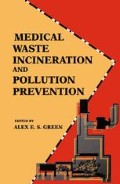Abstract
Incineration sterilizes and detoxifies medical waste and converts it to innocuous ash, reducing its weight and volume by 90 to 95 percent. However, there is concern about pollutants emitted into the air during the incineration of medical waste, especially acid gases, heavy metals, and dioxins. There is also concern about potentially toxic substances that remain in the ash residues. These pollutants are derived from the waste feed material and generally change in form during the combustion process. The concern increases as hospitals use larger quantities of disposable plastics. In addition, existing incinerator stacks are often short and located close to other buildings.
Access this chapter
Tax calculation will be finalised at checkout
Purchases are for personal use only
Preview
Unable to display preview. Download preview PDF.
References
Brown, H. L. Thomas Jefferson University Hospital waste characterization study. Drexel University. 1989.
CDC. “Guideline for handwashing and hospital environmental control, 1985.” Centers for Disease Control, U.S. Department of Health and Human Services, Washington, DC. NTIS PB85–923404, 1985.
CDC. “Recommendations for prevention of Human Immunodeficiency Virus (HIV) transmission in health-care settings.” Centers for Disease Control, U.S. Department of Health and Human Services, Washington, DC, Morbidity and Mortality Weekly Report, Vol. 36, August 21, 1987.
Domalski, E. S., T. Jobe, and T. A. Milne. 1986. Thermodynamic data for biomass conversion and waste incineration. SERI/SP-271–2839, Boulder, CO: Solar Energy Research Institute.
Doucet, L. G. “Institutional waste incineration problems and solutions.” Paper presented at Incineration of Low Level and Mixed Wastes Conference, St. Charles, IL, April 1987.
Hasselriis, F. “Relationship between waste composition and environmental impact.” Presented at the 83rd Annual Meeting of the Air and Waste Management Association, Pittsburgh, June 24–29, 1990.
Jack Faucett Associates. 1989. Draft, “Final infectious and chemotherapeutic waste plan.”
Morrison, R. 1987. Hospital waste combustion study—Data gathering phase. Radian Corp., Research Triangle Park, U.S. EPA Contract 68–02–4330.
Ontario Ministry of the Environment. A study of the quantity and type of disposable plastics used by different hospitals in Ontario. Ontario Ministry of the Environment, Waste Management Branch, No. 148907, March 1988.
Oviatt, V. R. 1968. Status report—Disposal of solid wastes. Hospitals 42: December 16.
U.S. EPA. 1986. EPA/530-SW-86–014, PB86–199130. Washington, DC: U.S. Environmental Protection Agency, Office of Solid Waste.
U.S. EPA. 1987. EPA/530-SW-87–0216. Municipal waste combustion study: Emission data base. Washington, DC: U.S. Environmental Protection Agency, Office of Solid Waste.
U.S. EPA. 1989. Federal Register, 40 CFR Parts 22 and 259. Washington, DC: U.S. Environmental Protection Agency, Office of Solid Waste.
U.S. EPA. 1990a. EPA/530-SW-90–051A Medical waste management in the United States—First interim report to congress. Washington, DC: U.S. Environmental Protection Agency, Office of Solid Waste.
U.S. EPA. 1990b. EPA/530-SW-90–087A, PB91–130187. Medical waste management in the United States—Second interim report to Congress. Washington, DC: U.S. Environmental Protection Agency, Office of Solid Waste.
Editor information
Editors and Affiliations
Rights and permissions
Copyright information
© 1992 Springer Science+Business Media New York
About this chapter
Cite this chapter
Hasselriis, F., Constantine, L. (1992). Characterization of Today’s Medical Waste. In: Green, A.E.S. (eds) Medical Waste Incineration and Pollution Prevention. Springer, Boston, MA. https://doi.org/10.1007/978-1-4615-3536-2_2
Download citation
DOI: https://doi.org/10.1007/978-1-4615-3536-2_2
Publisher Name: Springer, Boston, MA
Print ISBN: 978-1-4613-6569-3
Online ISBN: 978-1-4615-3536-2
eBook Packages: Springer Book Archive

